Accurately Modeling of Zero Biased Schottky-Diodes at Millimeter-Wave Frequencies
Abstract
:1. Introduction
2. Nonlinear Zero Bias Diode Modelling
2.1. DC Measurements and Nonlinear Model
2.2. Low-Frequency Model
2.3. Modified ZBD Model Up to W-Band
2.4. Large Signal Model Extraction and Validation
3. Diode Modelling Oriented to Flip-Chip Attachment Technique
Flip-Chip Zero Bias Diode Complete Model
4. Including Low-Frequency Noise in the Zero-Bias Model
5. Conclusions
Author Contributions
Funding
Acknowledgments
Conflicts of Interest
References
- Biebl, E.M. RF Systems Based on Active Integrated Antennas. Int. J. Electron. Commun. 2003, 57, 173–180. [Google Scholar] [CrossRef]
- Shi, Y.; Jing, J.; Fan, Y.; Yang, L.; Li, Y.; Wang, M. A novel compact broadband rectenna for ambient RF energy harvesting. Int. J. Electron. Commun. 2018, 95, 264–270. [Google Scholar] [CrossRef]
- Janin, S.; Sripimanwat, K.; Phongcharoenpanich, C.; Krairiksh, M. A hybrid ring coupler quasi-optical antenna-mixer. Int. J. Electron. Commun. 2009, 63, 36–45. [Google Scholar] [CrossRef]
- Yao, C.; Chen, Z.; Ge, J.; Zhou, M.; Wei, X. A compact 220 GHz heterodyne receiver module with planar Schottky diodes. Int. J. Electron. Commun. 2018, 84, 153–161. [Google Scholar] [CrossRef]
- Moyer, H.P.; Schulman, J.N.; Lynch, J.J.; Schaffner, J.H.; Sokolich, M.; Royter, Y.; Bowen, R.L.; McGuire, C.F.; Hu, M.; Schmitz, A. W-Band Sb-Diode Detector MMICs for Passive Millimeter Wave Imaging. IEEE Microw. Wirel. Compon. Lett. 2008, 18, 686–688. [Google Scholar] [CrossRef]
- Hrobak, K.M.; Sterns, M.; Schramm, M.; Stein, W.; Schmidt, L.P. Planar zero bias Schottky diode detector operating in the E- and W-band. In Proceedings of the International 2013 European Microwave Conference, Nuremberg, Germany, 6–10 October 2013; pp. 179–182. [Google Scholar] [CrossRef]
- Artal, E.; Aja, B.; de la Fuente, M.L.; Pascual, J.P.; Mediavilla, A.; Martinez-Gonzalez, E.; Pradell, L.; de Paco, P.; Bara, M.; Blanco, E.; et al. LFI 30 and 44 GHz receivers Back-end Modules. J. Instrum. 2009, 4, T12003. [Google Scholar] [CrossRef]
- Cano, J.L.; Aja, B.; Villa, E.; de la Fuente, L.; Artal, E. Broadband back-end module for radio-astronomy applications in the Ka-Band. In Proceedings of the 38th European Microwave Conference, Amsterdam, The Netherlands, 27–31 October 2008; pp. 1113–1116, ISBN 978-2-87487-006-4. [Google Scholar] [CrossRef]
- Gutiérrez, J.; Zeljami, K.; Villa, E.; Aja, B.; de la Fuente, M.L.; Sancho, S.; Pascual, J.P. Noise conversion of Schottky diodes in mm-wave detectors under different nonlinear regimes: Modeling and simulation versus measurement. Int. J. Microw. Wirel. Technol. 2016, 8, 479–493. [Google Scholar] [CrossRef]
- Xie, L.; Zhang, Y.; Fan, Y.; Xu, C.; Jiao, Y. A W-band Detector with High Tangential Signal Sensitivity and Voltage Sensitivity. In Proceedings of the 2010 International Conference on Microwave and Millimeter Wave Technology (ICMMT), Chengdu, China, 8–11 May 2010; pp. 528–531. [Google Scholar]
- Xu, K.; Zhang, Y.; Xie, L.; Fan, Y. A Broad W-band Detector Utilizing Zero-bias Direct Detection Circuitry. In Proceedings of the 2011 International Conference on Computational Problem-Solving (ICCP), Chengdu, China, 21–23 October 2011; pp. 190–194. [Google Scholar]
- Yao, C.; Zhou, M.; Luo, Y.; Xu, C. Millimeter wave broadband high sensitivity detectors with zero-bias Schottky diodes. J. Semicond. 2015, 36. [Google Scholar] [CrossRef]
- Tekbaş, M.; Erdoğan, M.S.; Ünal, İ. A W band waveguide detector module using zero bias schottky diode. In Proceedings of the 2017 IEEE 37th International Conference on Electronics and Nanotechnology (ELNANO), Kiev, Ukraine, 18–20 April 2017; pp. 137–142. [Google Scholar] [CrossRef]
- Hoefle, M.; Penirschke, A.; Cojocari, O.; Jakoby, R. Broadband zero-bias Schottky detector for E-field measurements up to 100 GHz and beyond. In Proceedings of the 2013 38th International Conference on Infrared, Millimeter, and Terahertz Waves (IRMMW-THz), Mainz, Germany, 1–6 September 2013; pp. 1–2. [Google Scholar] [CrossRef]
- Zhang, W.; Yang, F.; Wang, Z.X. W-band (90GHz) zero bias Schottky diode directive detector. In Proceedings of the 2015 Asia-Pacific Microwave Conference (APMC), Nanjing, China, 6–9 December 2015; pp. 1–3. [Google Scholar] [CrossRef]
- Tang, A.Y.; Drakinskiy, V.; Yhland, K.; Stenarson, J.; Bryllert, T.; Stake, J. Analytical Extraction of a Schottky Diode Model from Broadband S-Parameters. IEEE Trans. Microw. Theory Tech. 2013, 61, 1870–1878. [Google Scholar] [CrossRef]
- Zeljami, K.; Gutierrez, J.; Pascual, J.P.; Fernandez, T.; Tazon, A.; Boussouis, M. Characterization and Modeling of Schottky Diodes up to 110 GHz for Use in Both Flip-chip and Wire-Bonded Assembled Environments. Prog. Electromagn. Res. 2012, 131, 457–475. [Google Scholar] [CrossRef]
- Sze, S.M.; Ng, K.K. Physics of Semiconductor Devices; John Wiley & Sons Inc.: Hoboken, NJ, USA, 2007. [Google Scholar]
- Advanced Design System (ADS). Available online: https://www.keysight.com/en/pc-1297113/advanced-design-system-ads?cc=ES&lc=eng (accessed on 14 May 2019).
- Champlin, K.S.; Eisenstein, G. Cutoff frequency of submillimeter Schottky barrier diodes. IEEE Trans. Microw. Theory Tech. 1978, 26, 31–34. [Google Scholar] [CrossRef]
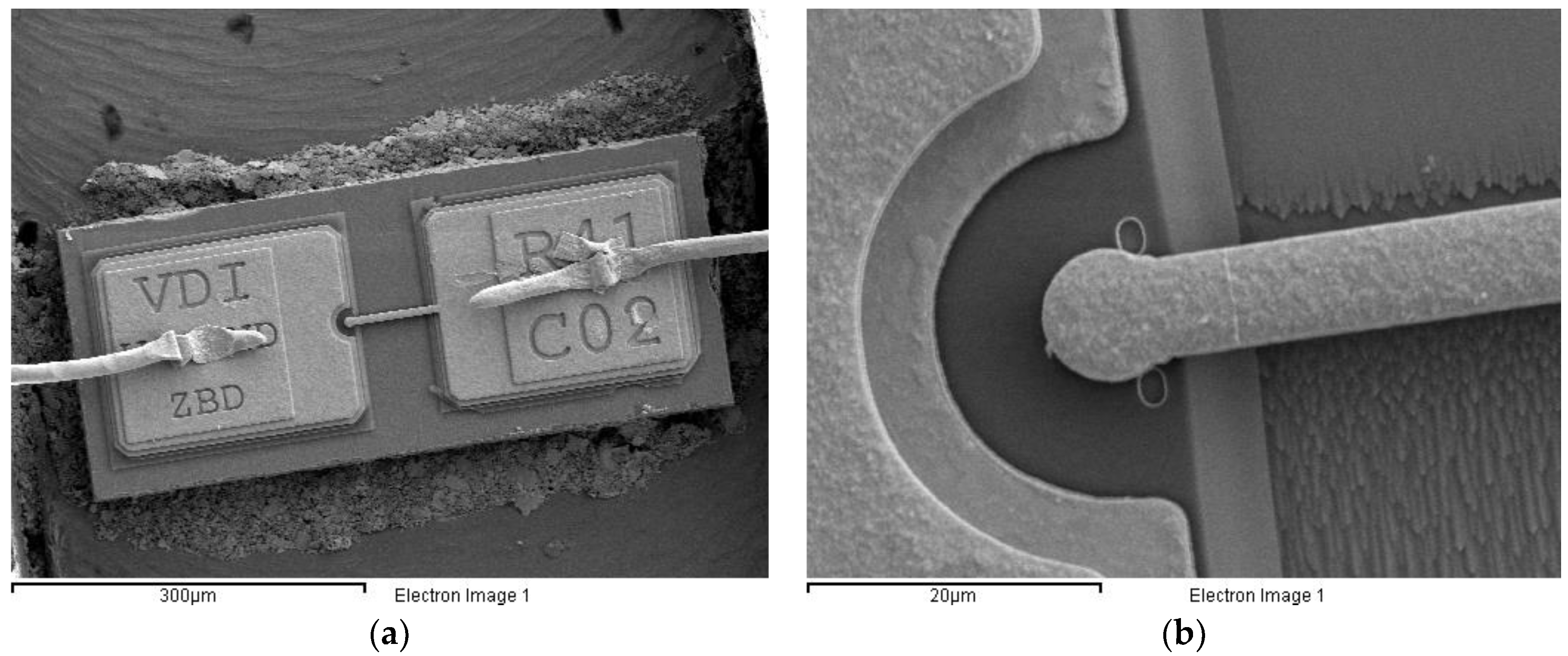
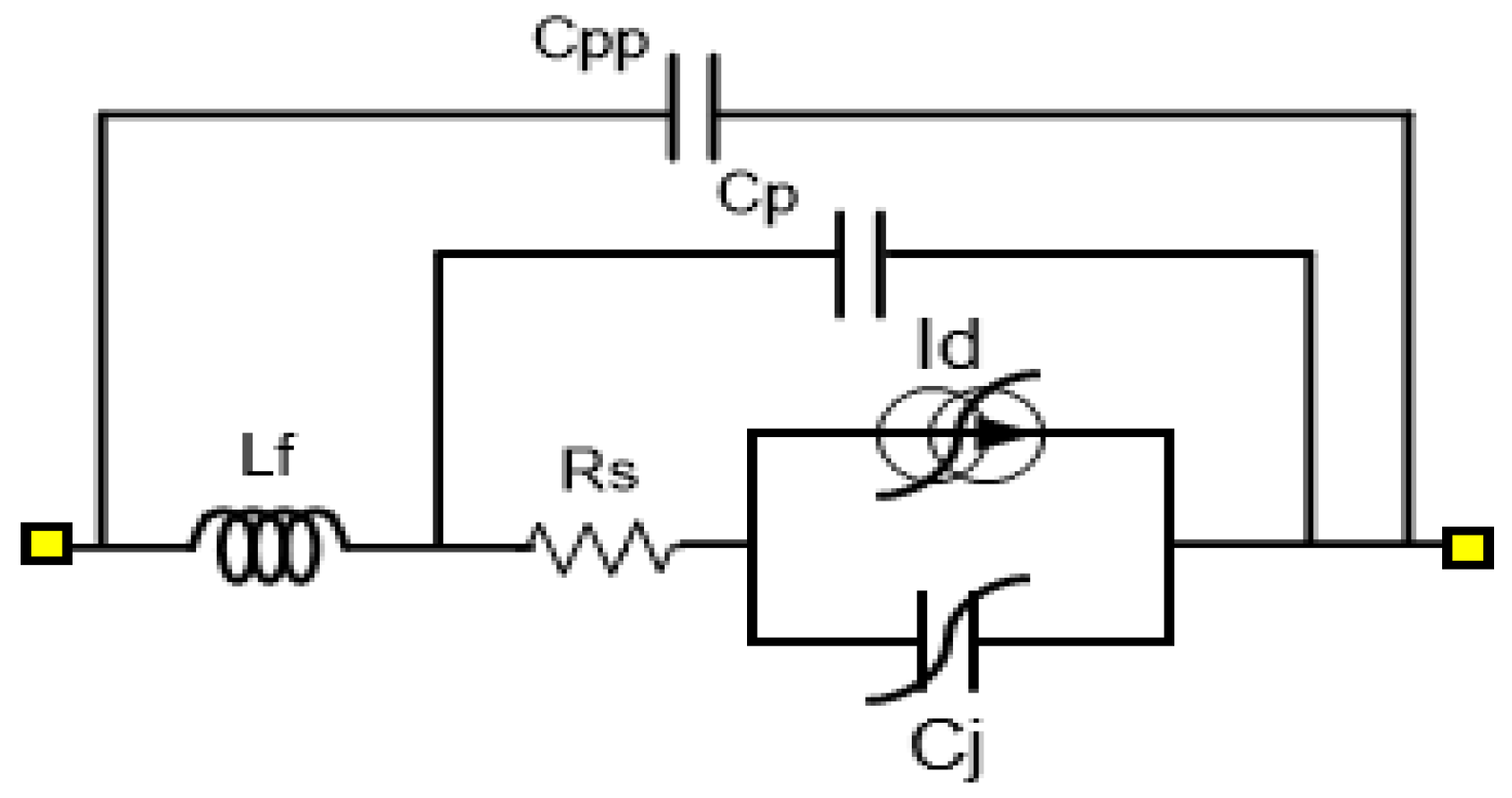
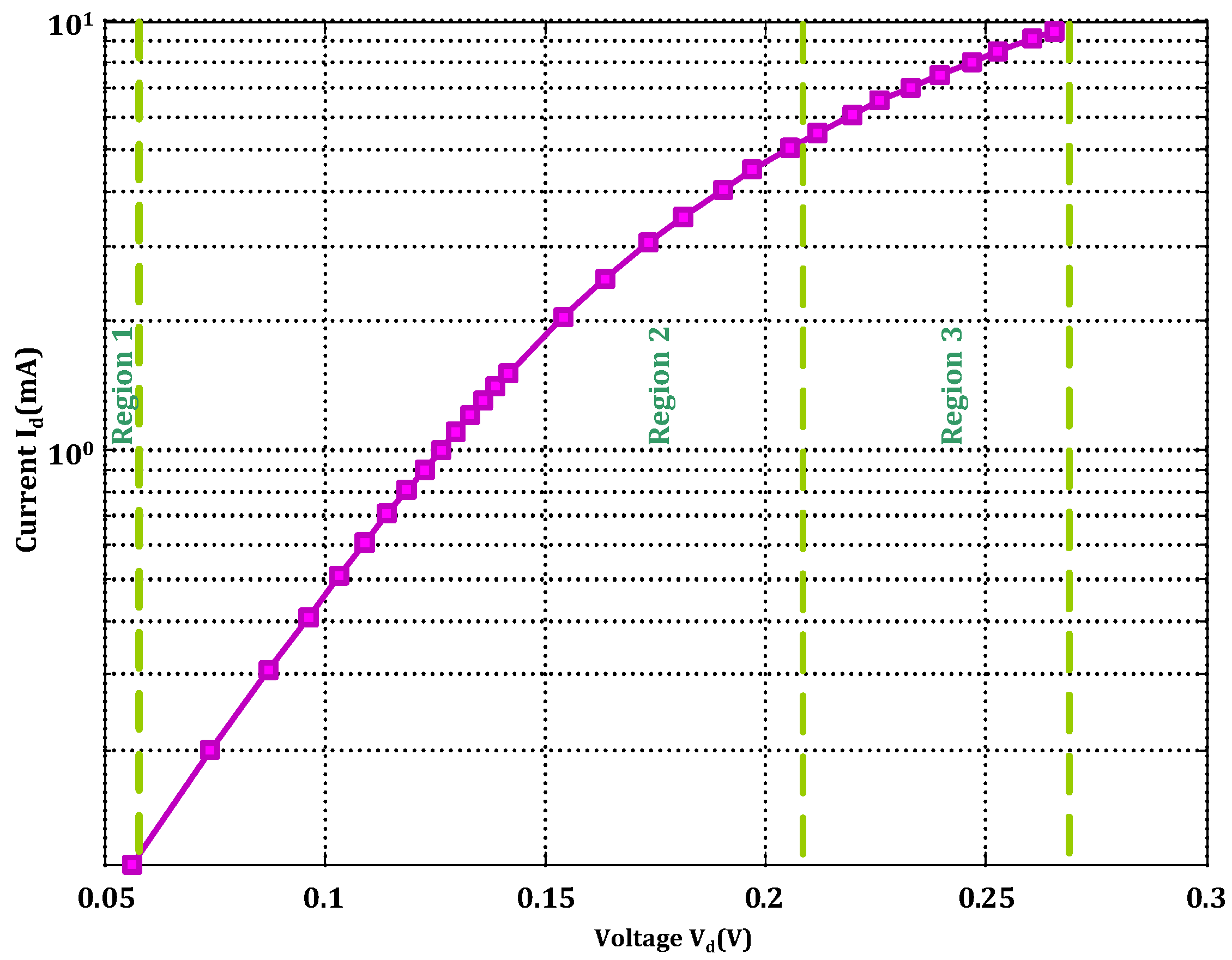
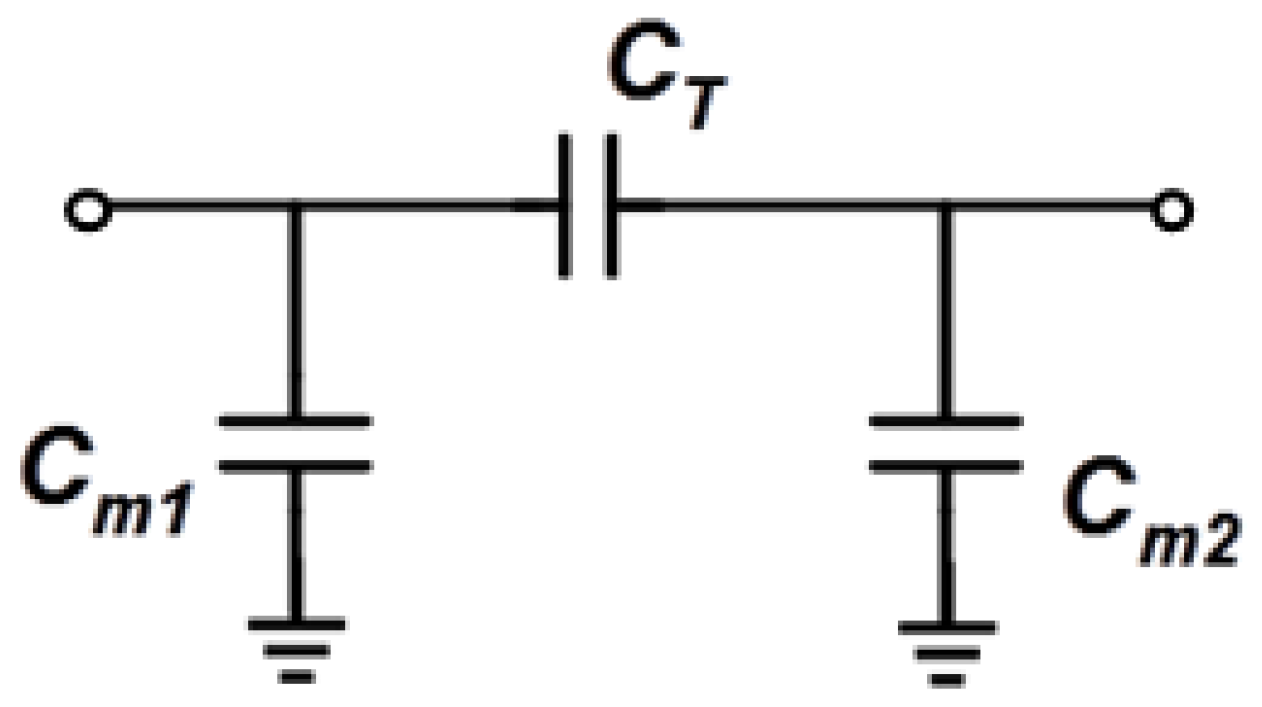
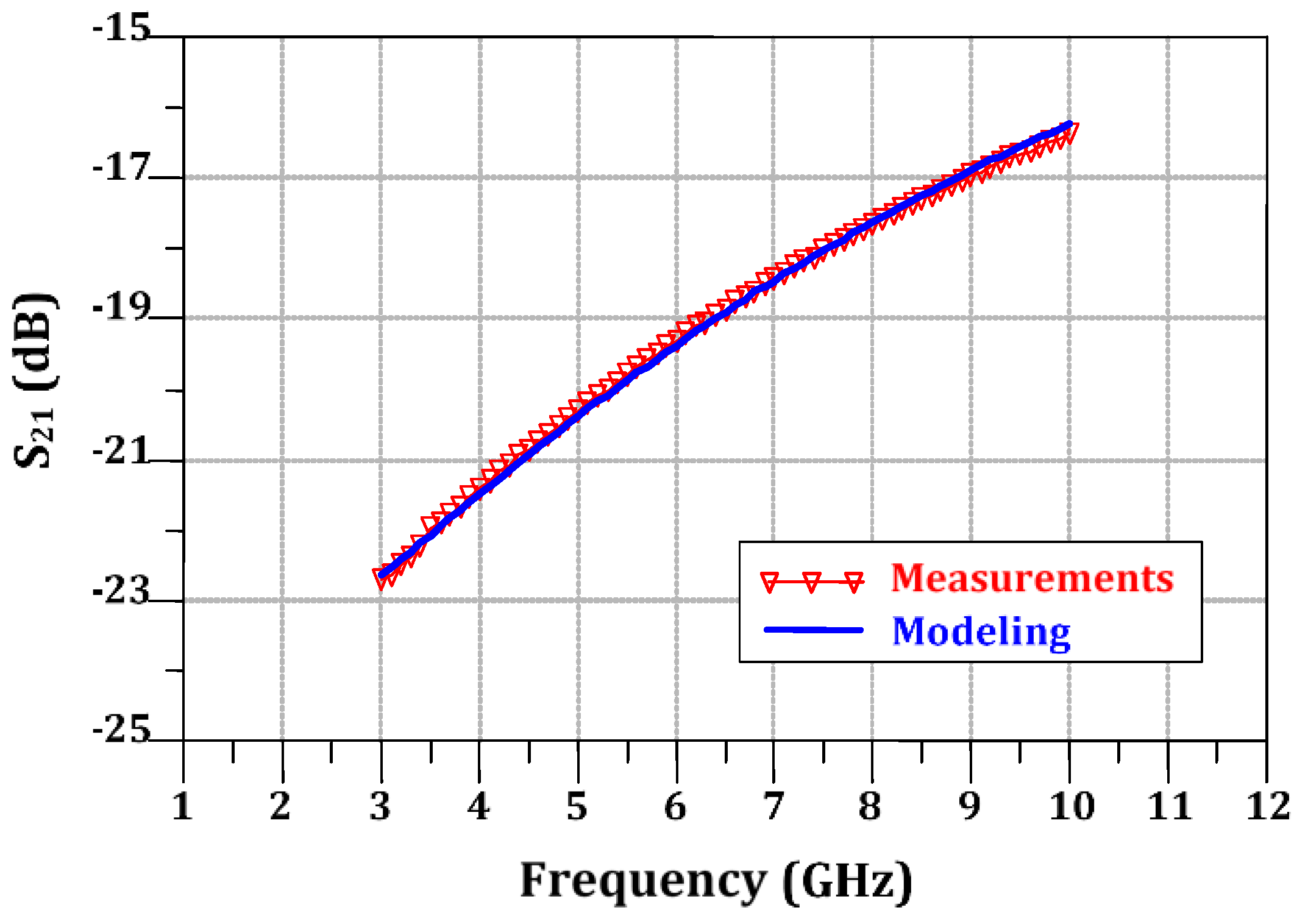

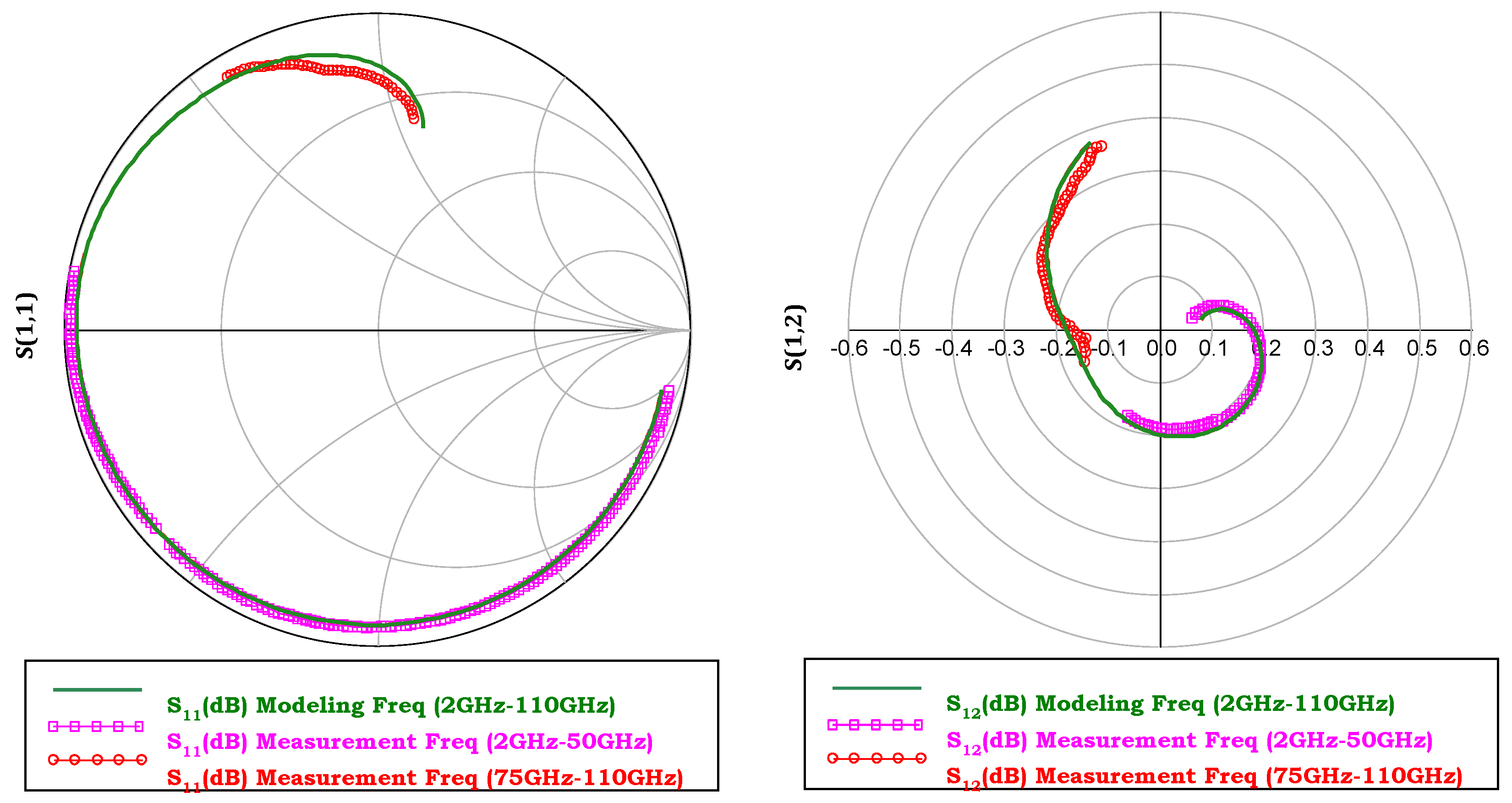
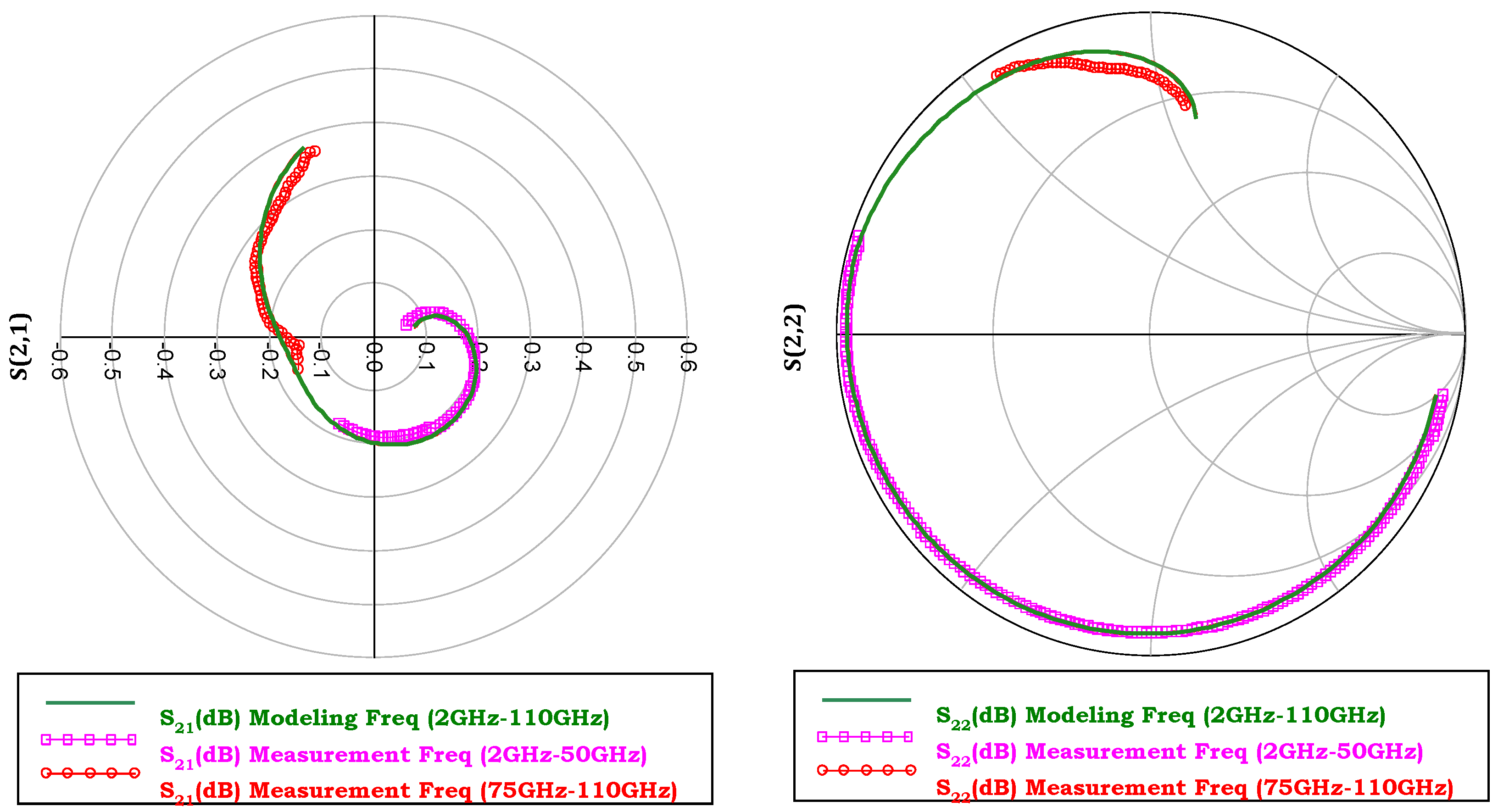

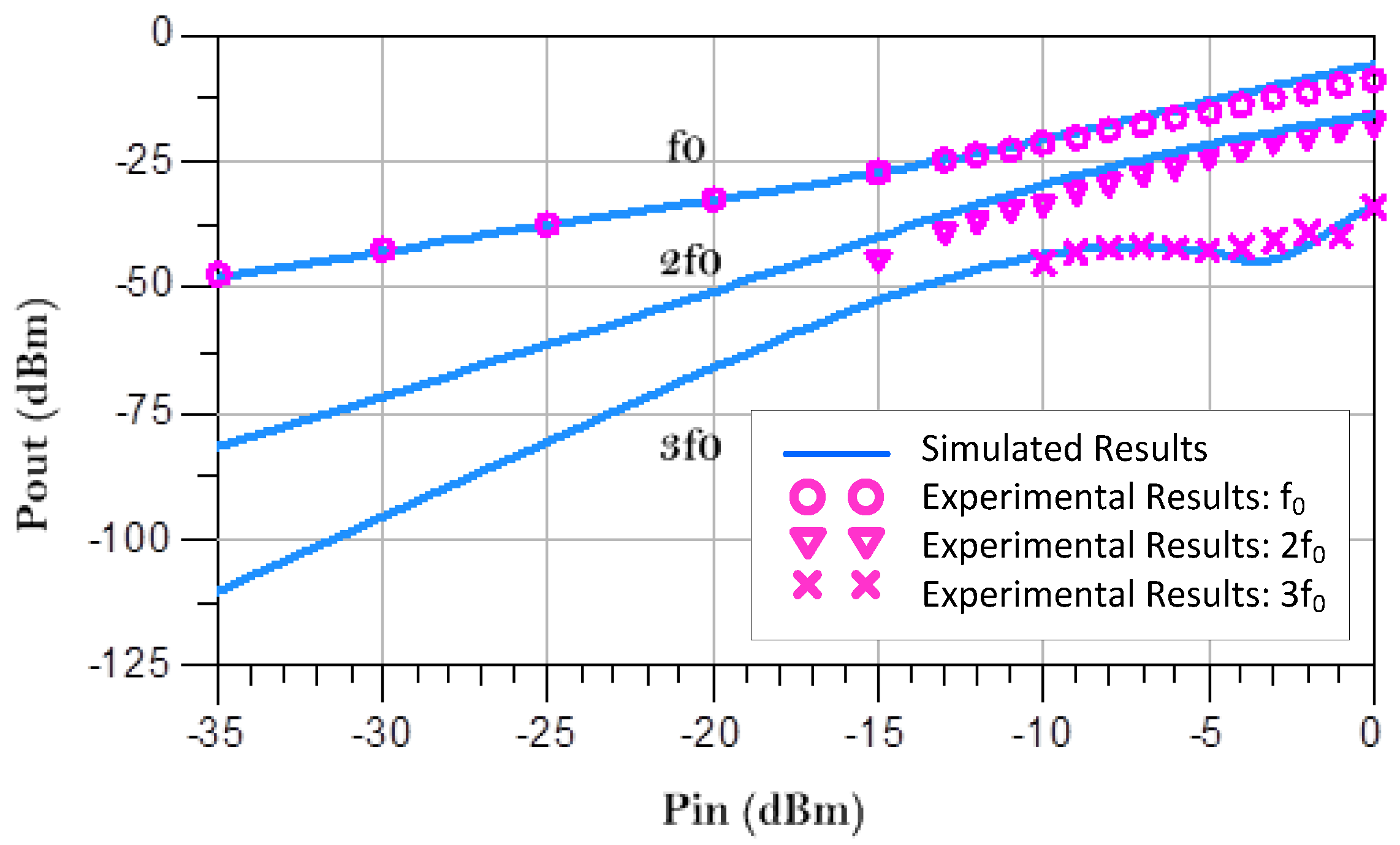
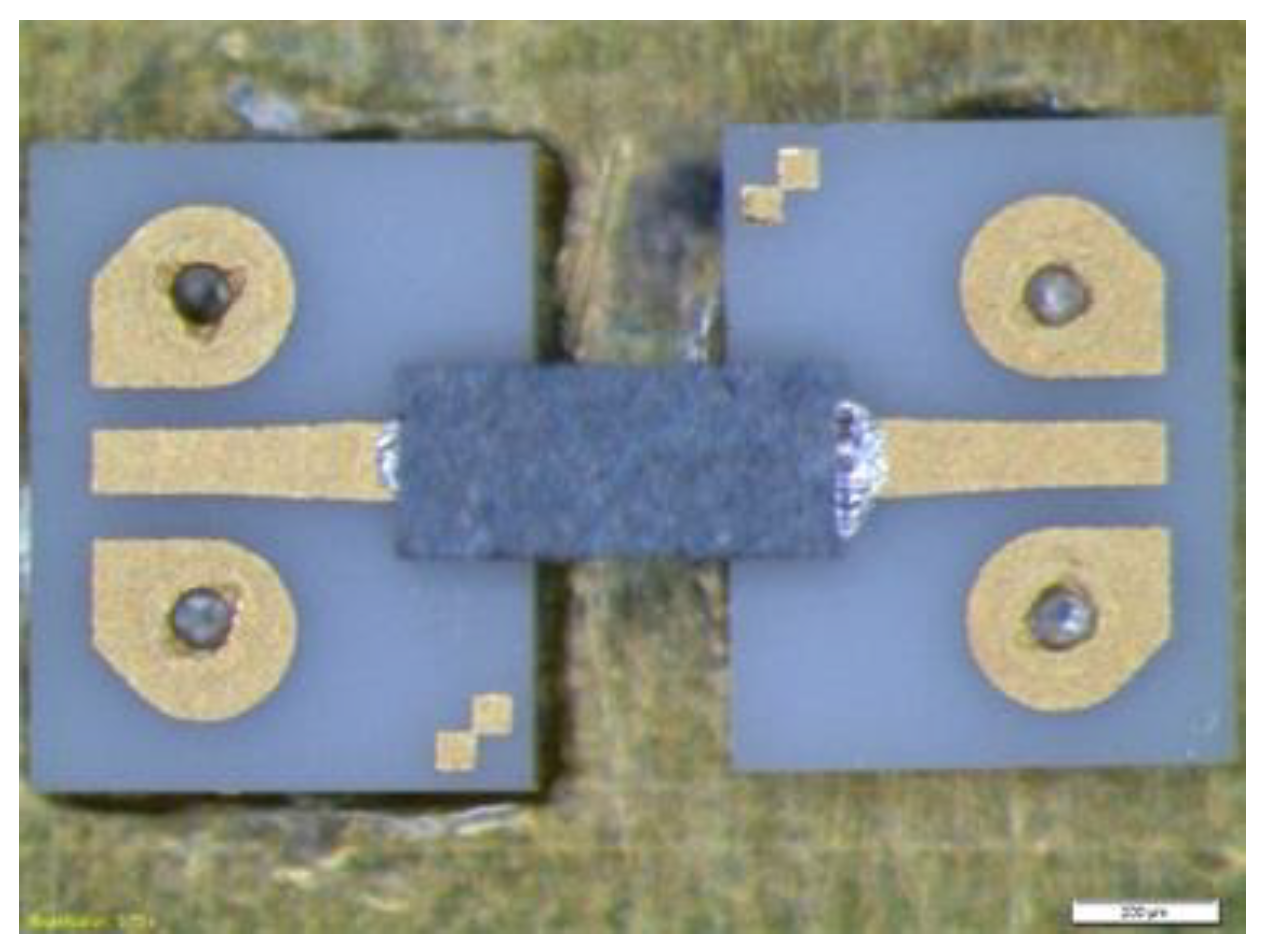
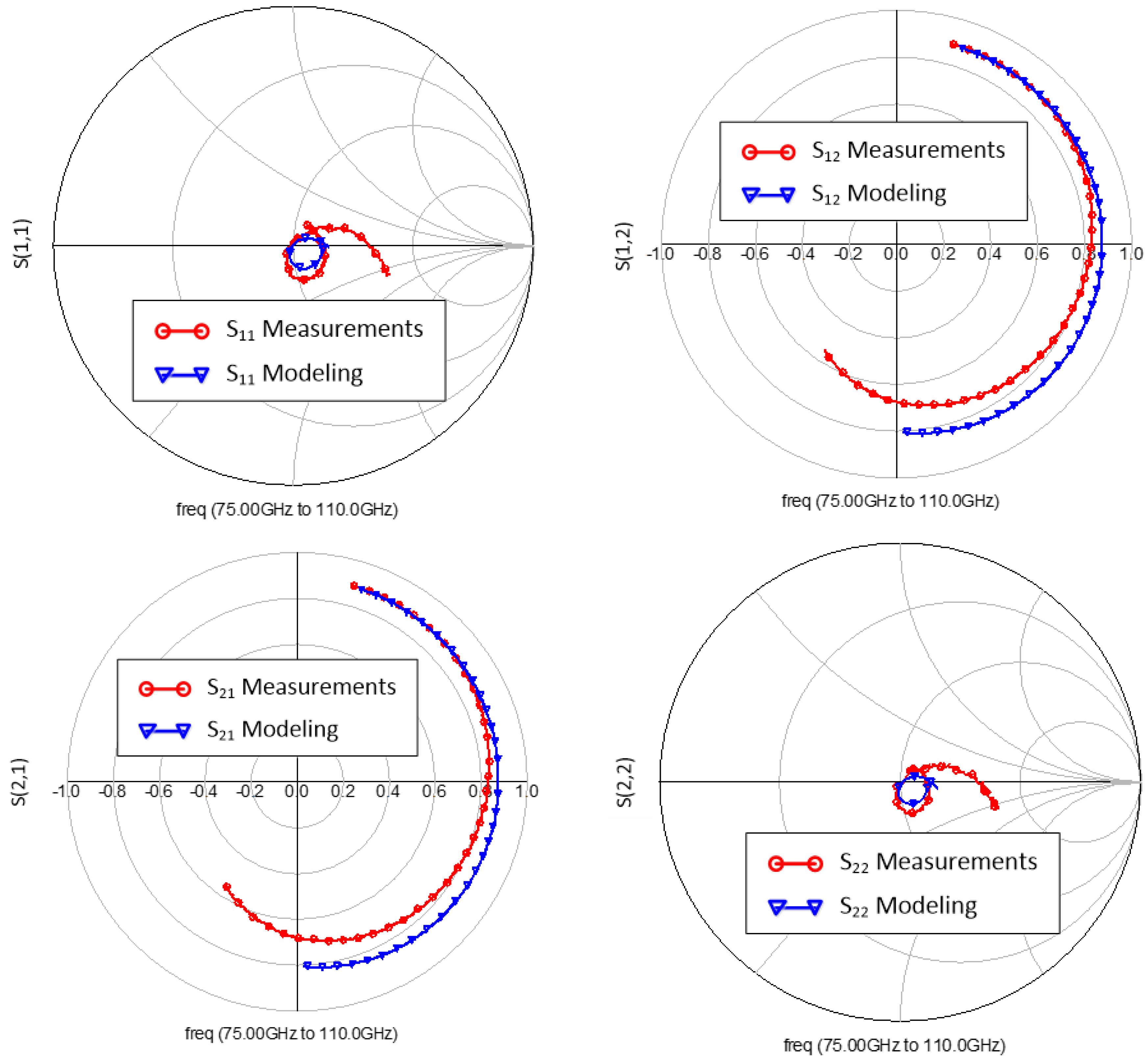
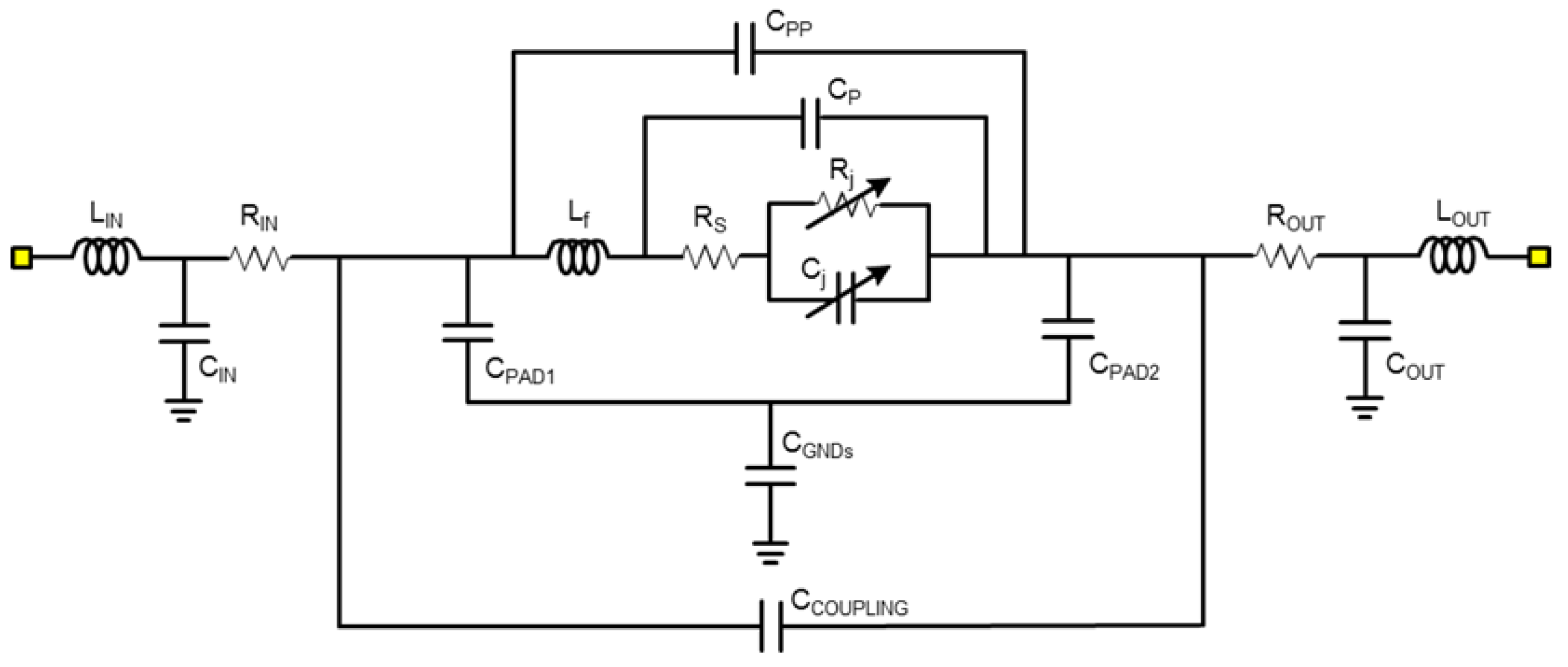
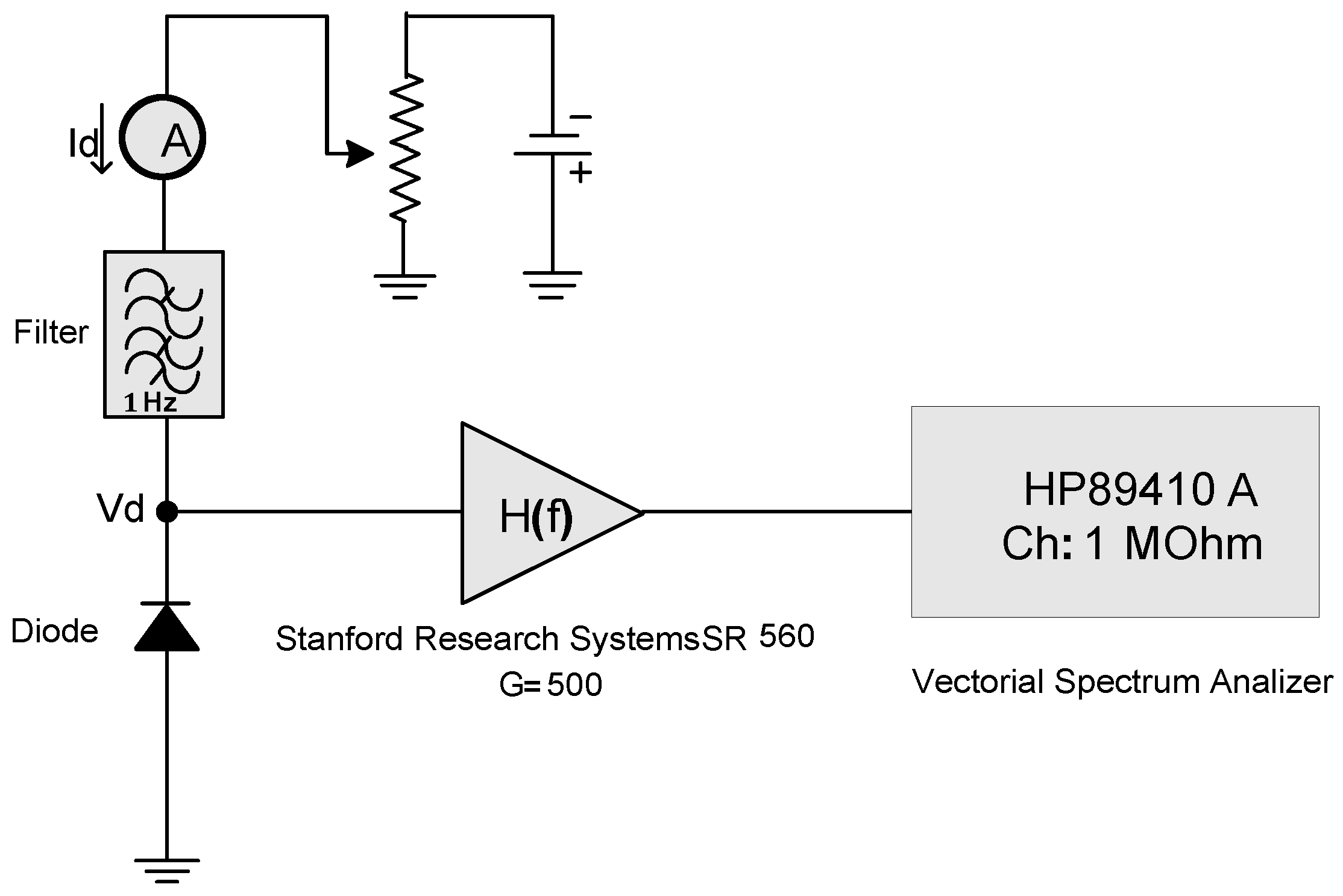
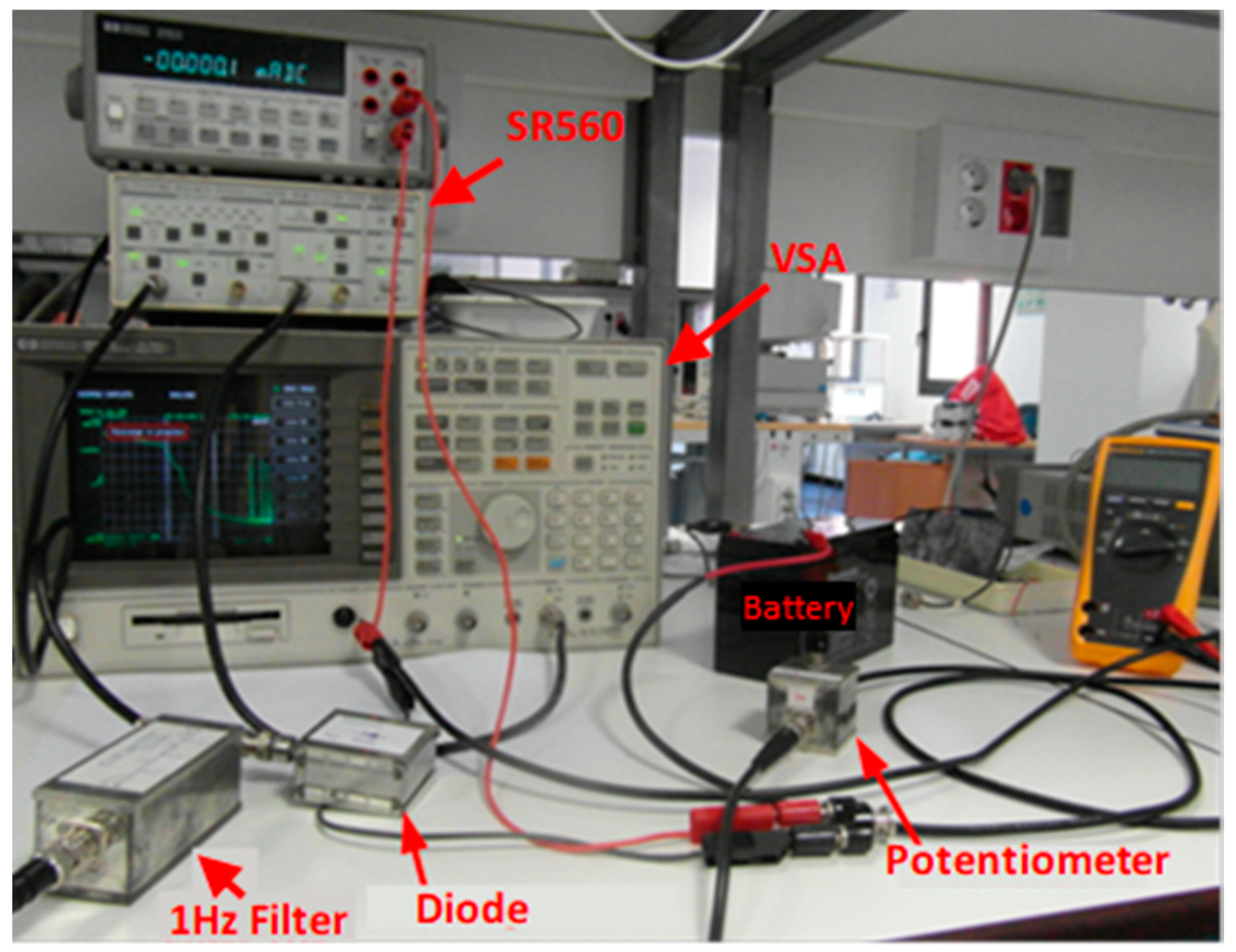
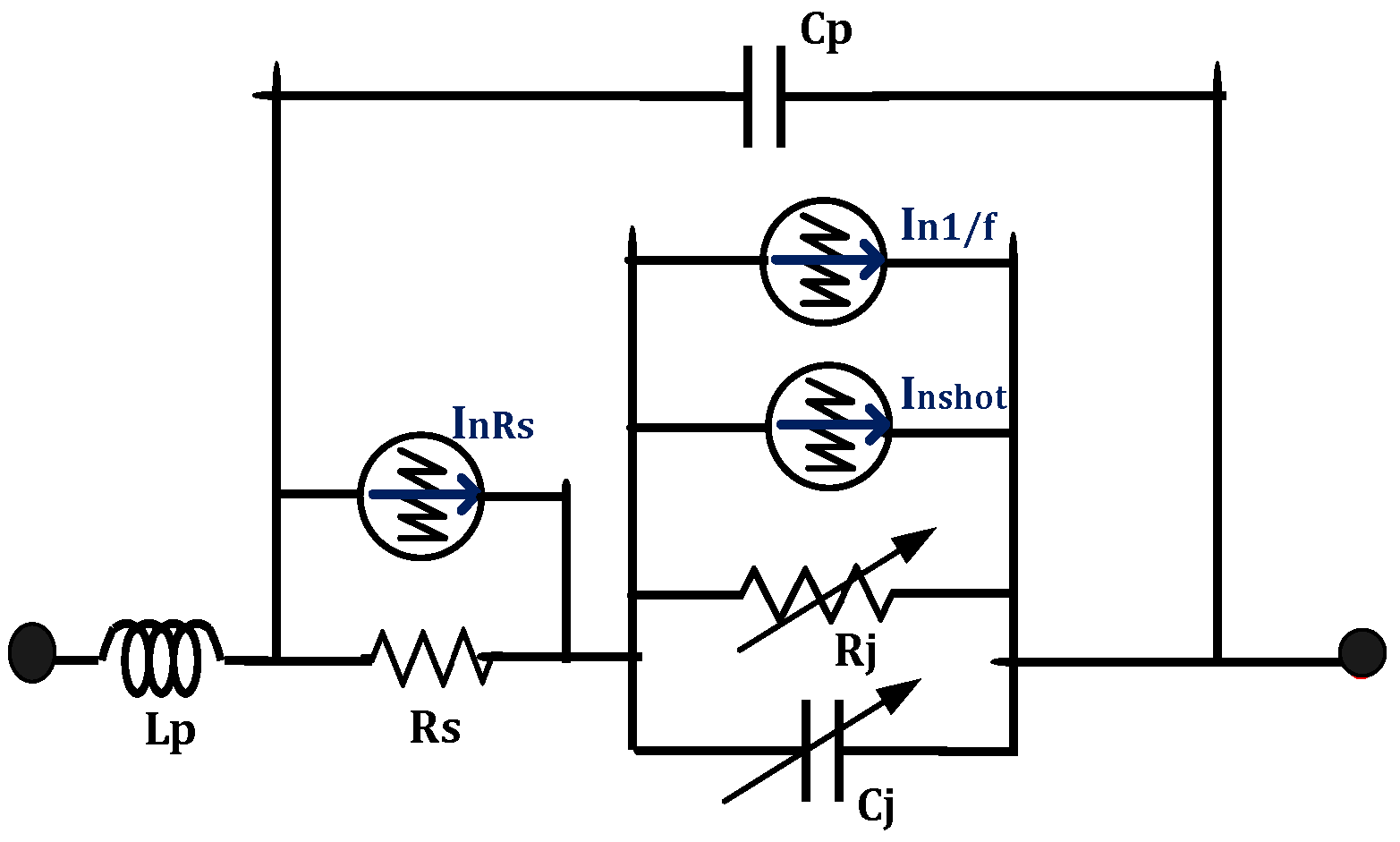
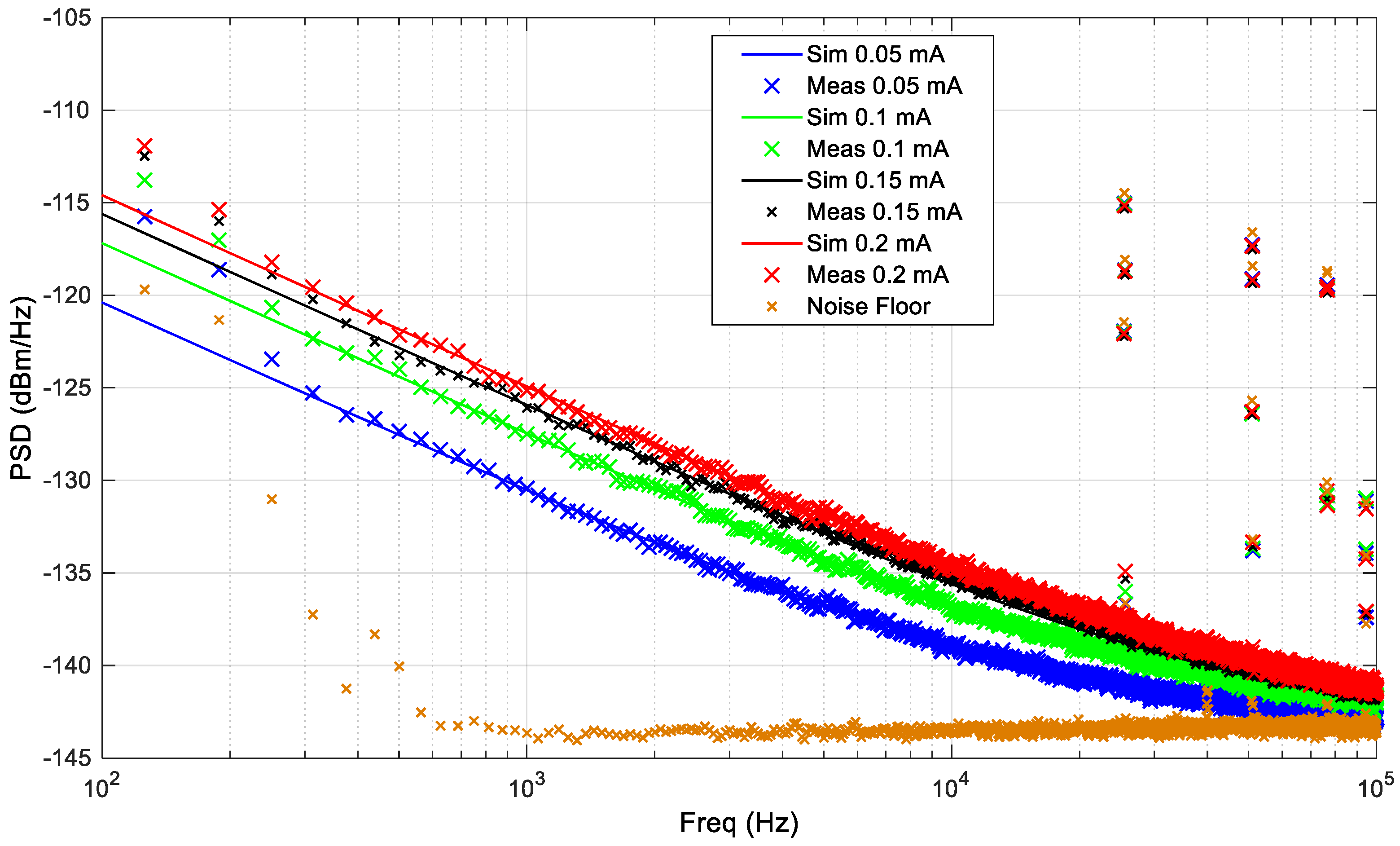
| Parameter | Value |
|---|---|
| Is (A) | 2.78 × 10−5 |
| η | 1.37 |
| (1/V) | 28.6 |
| Rs (Ω) | 6.48 |
| Parameter | Value |
|---|---|
| CT (fF) | 26 |
| Cj0 (fF) | 10 |
| Cpp (fF) | 16 |
| 0.16 | |
| Cm1 (fF) | 50 |
| Cm2 (fF) | 50 |
| Parameter | Symbol | Value | Parameter | Symbol | Value |
|---|---|---|---|---|---|
| Saturation Current (A) | Isat | 28 × 10−6 | Parasitic Finger Capacitance (fF) | Cp | 1 |
| Ideality Factor | η | 1.4 | Pad-to-Pad Capacitance (fF) | Cpp | 16 |
| (1/V) | α | 28.6 | Bonding Inductance (pH) | L1 | 73 |
| Junction Capacitance (Vd = 0 V) (fF) | Cj0 | 10 | Bonding Inductance (pH) | L2 | 42 |
| Series Resistance (Ω) | Rs | 6.5 | Pad Capacitance (fF) | C1 | 88 |
| Junction Potential (V) | 0.16 | Pad Capacitance (fF) | C2 | 51 | |
| Finger Inductance (pH) | Lf | 50 | Bonding Resistance (Ω) | R | 0 (Low Frequency) 3 (W Band) |
| Parameter | Symbol | Value |
|---|---|---|
| Saturation Current (A) | Isat | 28 × 10−6 |
| Ideality Factor | η | 1.4 |
| q/ηkT (1/V) | α | 28.6 |
| Junction Capacitance (Vd = 0 V) (fF) | Cj0 | 10 |
| Series Resistance (Ω) | RS | 6.5 |
| Junction Potential (V) | 0.16 | |
| Finger Inductance (pH) | Lf | 50 |
| Parasitic Capacitance (fF) | CP | 1 |
| Pad-to-Pad Capacitance (fF) | CPP | 16 |
| Input Inductance (pH) | LIN | 59 |
| Output Inductance (pH) | LOUT | 48 |
| Input Capacitance (fF) | CIN | 3.4 |
| Output Capacitance (fF) | COUT | 0.3 |
| Input Resistance (Ω) | RIN | 2.3 |
| Output Resistance (Ω) | ROUT | 2.3 |
| Coupling Capacitance (fF) | CCOUPLING | 18 |
| PAD IN Capacitance (fF) | CPAD1 | 39 |
| PAD OUT Capacitance (fF) | CPAD2 | 203 |
| Ground Capacitance (fF) | CGNDs | 11 |
| Parameter | Value |
|---|---|
| kf | 1.08 × 10−7 |
| af | 2.48 |
| bf | 1.04 |
© 2019 by the authors. Licensee MDPI, Basel, Switzerland. This article is an open access article distributed under the terms and conditions of the Creative Commons Attribution (CC BY) license (http://creativecommons.org/licenses/by/4.0/).
Share and Cite
Gutiérrez, J.; Zeljami, K.; Fernández, T.; Pascual, J.P.; Tazón, A. Accurately Modeling of Zero Biased Schottky-Diodes at Millimeter-Wave Frequencies. Electronics 2019, 8, 696. https://doi.org/10.3390/electronics8060696
Gutiérrez J, Zeljami K, Fernández T, Pascual JP, Tazón A. Accurately Modeling of Zero Biased Schottky-Diodes at Millimeter-Wave Frequencies. Electronics. 2019; 8(6):696. https://doi.org/10.3390/electronics8060696
Chicago/Turabian StyleGutiérrez, Jéssica, Kaoutar Zeljami, Tomás Fernández, Juan Pablo Pascual, and Antonio Tazón. 2019. "Accurately Modeling of Zero Biased Schottky-Diodes at Millimeter-Wave Frequencies" Electronics 8, no. 6: 696. https://doi.org/10.3390/electronics8060696
APA StyleGutiérrez, J., Zeljami, K., Fernández, T., Pascual, J. P., & Tazón, A. (2019). Accurately Modeling of Zero Biased Schottky-Diodes at Millimeter-Wave Frequencies. Electronics, 8(6), 696. https://doi.org/10.3390/electronics8060696






